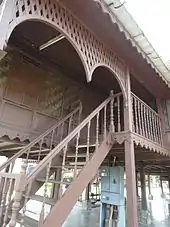Perakian Malay people
Perakian Malay people refers to a group of Malay people originating from the Malaysian state of Perak. As of 2010, it is estimated that the population of the Perakian Malays in Perak are about 55.74% of the state's population.[1]
_(14770286405).jpg.webp) A Perakian Malay woman with children in traditional attire, 1908. | |
| Total population | |
|---|---|
| 1,249,000[1] | |
| Regions with significant populations | |
| Languages | |
| Perak Malay, Malaysian language. | |
| Religion | |
| Islam | |
| Related ethnic groups | |
| Kedahan Malays, other Malaysian Malays |
Language
.jpg.webp)
Perakian Malays uses a distinct form of Malay variant known as Perak Malay. Linguistically, there are about five Malay dialects traditionally spoken in Perak, only one of which is intended by the name "Perak Malay" and it can be divided into two sub-dialects namely Perak Tengah sub-dialect and Kuala Kangsar sub-dialect. Other Malay dialects used in Perak include Perak Selatan dialect which is more influenced by Selangor Malay and Perak Ulu Malay dialect (also known as Basa Ulu or Basa Grik) but are not considered as part of Perak Malay as they do not share many similarities with Perak Malay but instead it is linguistically much closer to neighbouring Kelantan-Pattani Malay and other East Coast Malay varieties such as Terengganu Malay and Pahang Malay. Malaysian language is used as a second language and English as a third language.
Culture
Dance
Traditional Perakian Malay dance are such as:-[2]
- Dabus
- Bubu Menari
- Lenggok
- Zapin Gambus
- Belotah
- Sewang
Cuisine
Martial arts
- Silat Serimau Hitam
Notable people
- Abdullah Muhammad Shah II of Perak, the 26th Sultan of Perak and resistor of colonial British Malaya.[9]
- Ahmad Zahid Hamidi, Malaysia's current Deputy Prime Minister.
- Amy Mastura, Malaysian singer and actress.
- Awie, Malaysian singer and actor.
- Fauziah Latiff, Malaysian actress.
- Jamal Abdillah, Malaysian singer and actor.
- Jins Shamsuddin, Malaysian actor and film director.
- Mamat Khalid, Malaysian film director.
- Mohammad Nizar Jamaluddin, politician and former Menteri Besar of Perak.
- Mohd Nasir Basharuddin, Malaysian footballer.
- Ngah Ibrahim, Orang Kaya Mantri of Larut in 1858.[10]
- Mohammad Nor Khalid, a Malaysian cartoonist famously known as Lat
- Nazirul Naim Che Hashim, Malaysian footballer.
- Nurridzuan Abu Hassan, Malaysian footballer.
- Syazwan Roslan, Malaysian footballer.
References
- "Laporan Kiraan Permulaan 2010". Jabatan Perangkaan Malaysia. p. iv. Archived from the original on July 8, 2011. Retrieved 2016-02-05.
- "Tarian Tradisional Perak". Jabatan Kebudayaan dan Kesenian Negara. Retrieved 2016-02-05.
- "MAKANAN HAMPIR PUPUS PERAK - IKAN PINDANG DAUN SENIAR". dsh!. Retrieved 2016-02-05.
- "MAKANAN HAMPIR PUPUS PERAK - SAMBAL SERAI". dsh!. Retrieved 2016-02-05.
- "MAKANAN HAMPIR PUPUS PERAK - GULAI KEMAHANG". dsh!. Retrieved 2016-02-05.
- "MAKANAN HAMPIR PUPUS PERAK - KERABU UMBUT BAYAS". dsh!. Retrieved 2016-02-05.
- "MAKANAN HAMPIR PUPUS PERAK - KULAT SISIR". dsh!. Retrieved 2016-02-05.
- "MAKANAN HAMPIR PUPUS PERAK - PENJAN UBI". dsh!. Retrieved 2016-02-05.
- Thomas R. Metcalf (2008). Imperial Connections: India in the Indian Ocean Arena, 1860-1920. University of California Press. ISBN 978-05-202-5805-1.
- Salma Nasution Khoo & Abdur-Razzaq Lubis (2005). Kinta Valley: Pioneering Malaysia's Modern Development. Areca Books. ISBN 98-342-1130-9.
.jpg.webp)
